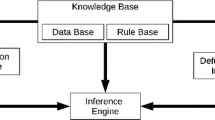Abstract
The fuzzy decision tree (FDT) is a powerful, top–down, hierarchical search scheme to extract human interpretable classification rules. Furthermore, the FDT is considered an approach to model a system by making use of a descriptive language with fuzzy logic and fuzzy predicates. There exist two contradictory requirements with fuzzy modeling, namely, accuracy and interpretability. In this study, the subtractive clustering and a multi-objective evolutionary algorithm are used to develop a novel fuzzy modeling scheme based on the FDT classifier to construct an accurate and interpretable system that is defined as the interpretability-based fuzzy decision tree classifier. Two interpretability measures, namely, complexity interpretability and semantics interpretability are considered to reach acceptable accuracy. These measures are optimized as different objectives within the multi-objective framework. Results obtained in several benchmark classification problems are encouraging because they show the ability of the developed scheme while yielding accuracy comparable to that achieved by other methods like neural networks and the crisp decision tree (C4.5). The experimental results demonstrate the superiority of the developed scheme.





Similar content being viewed by others

References
Alonso JM, Magdalena L (2011) HILK++: an interpretability-guided fuzzy modeling methodology for learning readable and comprehensible fuzzy rule-based classifiers. Soft Comput 15:1959–1980
Alonso JM, Magdalena L, Guillaume S (2008) HILK: a new methodology for designing highly interpretable linguistic knowledge bases using the fuzzy logic formalism. Int J Intell Syst 23(7):761–794
Alonso JM, Magdalena L, Gonzalez-Rodriguez G (2009) Looking for a good fuzzy system interpretability index. An experimental approach. Int J Approx Reason 51(1):115–134
Bezdek JC (1981) Pattern recognition with fuzzy objective function algorithms. Plenum Press, New York
Botta A, Lazzerini B, Marcelloni F, Stefanescu D (2009) Context adaptation of fuzzy systems through a multiobjective evolutionary approach based on a novel interpretability index. Soft Comput 13(5):437–449
Chen MY (2002) Establishing interpretable fuzzy models from numeric data. In: 4th world congress on intelligent control and automation. IEEE, pp 1857–1861
Chiu S (1994) Fuzzy model identification based on cluster estimation. J Intell Fuzzy Syst 2(3):267–278
Coello CA, Lamont GB, Veldhuizen DAV (eds) (2002) Evolutionary algorithms for solving multi-objective problems. Kluwer, Norwell
Deb K, Pratab A, Agrawal S, Meyarivan T (2002) A fast and elitist multiobjective genetic algorithm: NSGA II. IEEE Trans Evol Comput 6(2):182–197
Eftekhari M, Katebi SD, Karimi M, Jahanmiri AH (2008) Eliciting transparent fuzzy model using differential evolution. Appl Soft Comput 8:466–476
Frank A, Asuncion A (2010) UCI Machine Learning Repository. Irvine, CA: University of California, School of Information and Computer Science. http://archive.ics.uci.edu/ml
Gacto MJ, Alcalà R, Herrera F (2010) Integration of an index to preserve the semantic interpretability in the multiobjective evolutionary rule selection and tuning of linguistic fuzzy systems. IEEE Trans Fuzzy Syst 18(3):515–531
Gacto MJ, Alcalá R, Herrera F (2011) Interpretability of linguistic fuzzy rule-based systems: an overview of interpretability measures. Inf Sci 181:4340–4360
Janikow CZ (1998) Fuzzy decision trees: issues and methods. IEEE Trans Syst Man Cybern 28(1):1–14
Lai RK, Fan C-Y, Huang W-H, Chang P-C (2009) Evolving and clustering fuzzy decision tree for financial time series data forecasting. Exp Syst Appl 36:3761–3773
Mendonca LF, Vieira SM, Sousa JMC (2007) Decision tree search methods in fuzzy modeling and classification. Int J Approx Reason 44:106–123
Mitra S, Konwar KM, Sankar KP (2002) Fuzzy decision tree, linguistic rules and fuzzy knowledge-based network: generation and evaluation. IEEE Trans Syst Man Cybern Part C Appl Rev 32(4):328–339
Murphy PM, Pazzani MJ (1994) Exploring the decision forest: an empirical investigation of Occam’s razor in decision tree induction. J Artif Intell Res 1:257–275
Pedrycz W, Sosnowski ZA (2000) Designing decision trees with the use of fuzzy granulation. IEEE Trans Syst Man Cybern Part A 30(2):151–159
Pedrycz W, Sosnowski ZA (2001) The design of decision trees in the framework of granular data and their application to software quality models. Fuzzy Sets Syst 123(3):271–290
Pedrycz W, Sosnowski ZA (2005) C-fuzzy decision trees. IEEE Trans Syst Man Cybern Part C 35(4):498–511
Pulkkinen P, Koivisto H (2008) Fuzzy classifier identification using decision tree and multiobjective evolutionary algorithms. Int J Approx Reason 48(2):526–543
Quinlan JR (1986) Induction of decision trees. Mach Learn 1:81–106
Quinlan JR (1993) C.45: programs for machine learning. Morgan Kaufmann Publishers Inc, San Francisco
Umano M, Okamoto H, Hatono I, Tamura H, Kawachi F, Umedzu S, Kinoshita J (1994) Fuzzy decision trees by fuzzy ID3 algorithm and its application to diagnosis systems. In: Proceedings of the third IEEE conference on fuzzy systems, vol 3, pp 2113–2118
Wang X-Z, Chen B, Qian G, Ye F (2000) On the optimization of fuzzy decision trees. Fuzzy Sets Syst 112:117–125
Xizhao W, Hong J (1998) On the handling of fuzziness for continuous valued attributes in decision tree generation. Fuzzy Sets Syst 99:283–290
Yager RR (1998) On the construction of hierarchical fuzzy systems models. IEEE Trans Syst Man Cybern 28(1):55–66
Zadeh LA (1999) From computing with numbers to computing with words–From manipulation of measurements to manipulation of perceptions. IEEE Trans Circuits Syst I Fundam Theory Appl 45(1):105–119
Zhou SM, Gan JQ (2008) Low-level interpretability and high-level interpretability: a unified view of data-driven interpretable fuzzy system modelling. Fuzzy Sets Syst 159(23):3091–3131
Zitzler E, Laumanns M, Thiele L (2001) SPEA2: improving the strength Pareto evolutionary algorithm for multiobjective optimization. In: Proceedings of evolutionary methods for design, optimisation and control with application to industrial problems (EUROGEN), Barcelona, Spain, pp 95–100
Acknowledgments
The authors thank the anonymous reviewers for their helpful suggestions.
Author information
Authors and Affiliations
Corresponding author
Additional information
Communicated by V. Piuri.
Rights and permissions
About this article
Cite this article
Afsari, F., Eftekhari, M., Eslami, E. et al. Interpretability-based fuzzy decision tree classifier a hybrid of the subtractive clustering and the multi-objective evolutionary algorithm. Soft Comput 17, 1673–1686 (2013). https://doi.org/10.1007/s00500-013-0981-2
Published:
Issue Date:
DOI: https://doi.org/10.1007/s00500-013-0981-2



